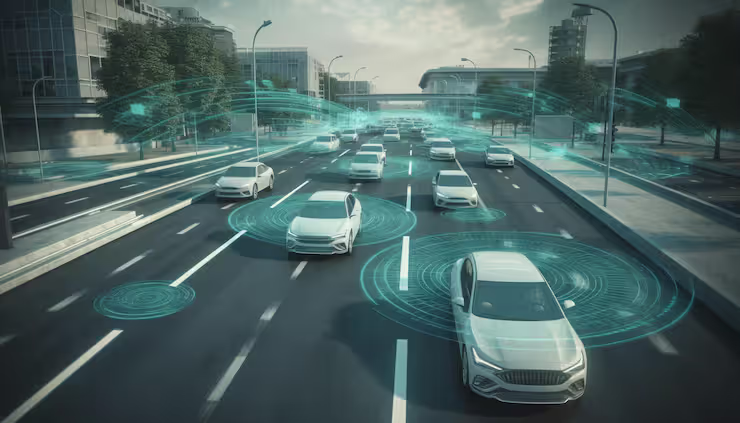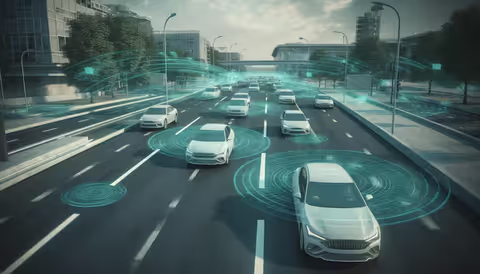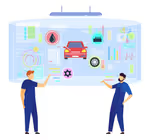
Learn the Basics and Key Details of Modern Autonomous Vehicle Systems
Autonomous vehicle systems are technologies that enable vehicles to navigate and operate with minimal or no human intervention. They rely on sensors such as cameras, radar, and lidar; high-definition mapping; artificial intelligence; and automation software to perceive the environment, make decisions, and execute driving actions.
The main purpose of developing autonomous systems is to enhance road safety, efficiency, and accessibility. Human error contributes to the majority of road accidents, and by automating driving tasks, these systems aim to reduce risk and improve mobility for all.

Automation in vehicles is classified into six levels, known as the SAE Levels of Driving Automation.
| Level | Description |
|---|---|
| 0 | No automation — the driver performs all tasks. |
| 1 | Driver assistance (steering or acceleration control). |
| 2 | Partial automation — the system manages steering and speed under supervision. |
| 3 | Conditional automation — the vehicle can drive itself under specific conditions but requires driver intervention. |
| 4 | High automation — the vehicle drives itself in defined areas without driver supervision. |
| 5 | Full automation — the vehicle handles all driving in all conditions without human input. |
These systems form the foundation of smart mobility—combining vehicle intelligence, connectivity, and sustainable innovation.
Importance
Autonomous vehicle systems are among the most impactful technological shifts in modern transportation. They influence industries, governments, and individuals worldwide.
Why they matter:
-
Enhanced Safety: Automation aims to minimize collisions caused by distractions, fatigue, or misjudgment.
-
Wider Mobility Access: They can provide independence for elderly or disabled individuals who cannot drive.
-
Improved Efficiency: Connected autonomous systems optimize traffic flow, reduce congestion, and enhance fuel and time efficiency.
-
Economic Transformation: The rise of automated fleets, AI-driven transport, and data-based logistics is reshaping the automotive ecosystem.
-
Environmental Benefits: When integrated with electric powertrains, autonomous systems can reduce emissions and improve energy use.
Who is impacted:
-
Manufacturers and Suppliers: Integrate AI, sensors, and connectivity into production.
-
Technology Companies: Drive innovation in mapping, data analytics, and cloud computing.
-
Governments and Regulators: Create policies for safety, testing, and ethical standards.
-
Consumers and Communities: Experience safer, more efficient, and accessible mobility.
-
Urban Planners and Insurers: Prepare cities, roads, and laws for the shift toward intelligent transport.
The significance of these systems lies not only in technological progress but also in their social and economic impact on everyday life.
Recent Updates
Autonomous vehicle development has advanced rapidly over the past year, showing real-world testing, strategic partnerships, and policy attention worldwide.
-
AI Integration: Leading automakers are now embedding advanced artificial intelligence chips and neural networks to improve perception and decision-making accuracy.
-
Collaborative Innovation: Major partnerships between automotive brands and tech startups are accelerating the timeline for partial and high-automation levels.
-
Fleet Pilots and Testing Zones: Many regions are introducing semi-autonomous public transport pilots, such as campus shuttles and geo-fenced vehicles.
-
Focus on Safety Validation: Research in 2024–2025 emphasizes real-world testing for “edge cases” such as unpredictable pedestrian movement, weather interference, and multi-vehicle coordination.
-
Emerging Markets: Countries in Asia, including India, are exploring semi-autonomous solutions to improve road safety and logistics efficiency, though large-scale driverless deployment remains under evaluation.
The general industry direction shows that Levels 2–4 systems are being widely adopted, while Level 5 vehicles remain a long-term goal.
Laws or Policies
Policies governing autonomous vehicles are evolving to balance innovation with safety, accountability, and data security.
Global Policy Frameworks:
-
International standards define automation levels and safety benchmarks to guide manufacturers.
-
Regulations are expanding for lane-keeping systems, driver-assistance technologies, and automated emergency braking.
-
Governments are encouraging testing programs under controlled environments to validate vehicle safety and reliability.
India’s Policy Context:
-
The current Motor Vehicles Act does not yet explicitly cover autonomous vehicles, creating a gap in national regulation.
-
Multiple laws—covering liability, consumer protection, data privacy, and information technology—are under review to accommodate autonomous operations.
-
Pilot testing is allowed under human supervision in limited zones; full deployment awaits comprehensive legal and safety frameworks.
-
The policy direction emphasizes road infrastructure readiness, clear safety standards, and integration of AI ethics in vehicle development.
Key Regulatory Focus Areas:
-
Safety certification for autonomous systems
-
Cybersecurity protection for vehicle networks
-
Data governance and privacy of connected vehicles
-
Liability frameworks when human drivers are absent
-
Integration of vehicle-to-infrastructure (V2X) technologies
Well-structured regulations are essential to ensure public trust and industry confidence in autonomous mobility.
Tools and Resources
A variety of tools and platforms support learning, research, and system development in autonomous driving:
-
SAE Automation Frameworks: Defines automation levels and standard terminology.
-
Simulation Platforms: Software tools that enable testing of sensors, algorithms, and traffic conditions in virtual environments.
-
Mapping and Localization Tools: High-definition mapping platforms and 3D modeling systems for precise vehicle navigation.
-
Data Analytics Dashboards: Real-time analytics tools for traffic flow, safety performance, and AI model validation.
-
Mobility Research Portals: Academic databases and government mobility programs offering case studies and policy updates.
-
Infrastructure Readiness Checklists: Frameworks for evaluating road design, communication systems, and digital connectivity for AV deployment.
-
Autonomous System Benchmarks: Open datasets and test suites for evaluating sensor fusion and perception accuracy.
These resources help engineers, policymakers, and researchers explore the next generation of intelligent transportation systems.
FAQs
Q: Are fully self-driving vehicles available today?
A: Fully autonomous (Level 5) vehicles are still under development. Most commercial models currently operate at Levels 2–3, providing advanced driver assistance rather than complete automation.
Q: What’s the difference between autonomous and automated vehicles?
A: “Automated” vehicles refer to those that perform certain driving tasks, while “autonomous” often implies full independence. In industry standards, “automated vehicle” is the preferred term to describe varying levels of automation.
Q: How do autonomous vehicles detect obstacles and navigate safely?
A: They use a combination of sensors such as radar, lidar, and cameras, supported by AI algorithms, to interpret surroundings and make real-time driving decisions.
Q: What are the biggest challenges for deploying these systems?
A: The primary challenges include environmental unpredictability, infrastructure readiness, sensor reliability, cybersecurity, and establishing legal liability for accidents.
Q: Will autonomous vehicles replace human drivers?
A: Not immediately. The transition will be gradual—starting with assistance systems and evolving toward higher autonomy. Human supervision and oversight will remain critical for several years.
Conclusion
Modern autonomous vehicle systems mark a defining chapter in the evolution of transportation. By merging artificial intelligence, sensing technologies, and connectivity, they are transforming how we move, plan, and experience mobility.
The road to full autonomy is complex, involving technological reliability, regulatory support, and societal readiness. As global collaboration intensifies and infrastructure modernizes, autonomous systems will continue to advance from assisted driving toward intelligent, adaptive mobility ecosystems.
For researchers, engineers, and policymakers, understanding the core technologies, emerging policies, and practical resources behind autonomous systems is essential for shaping a safer and smarter transport future.




